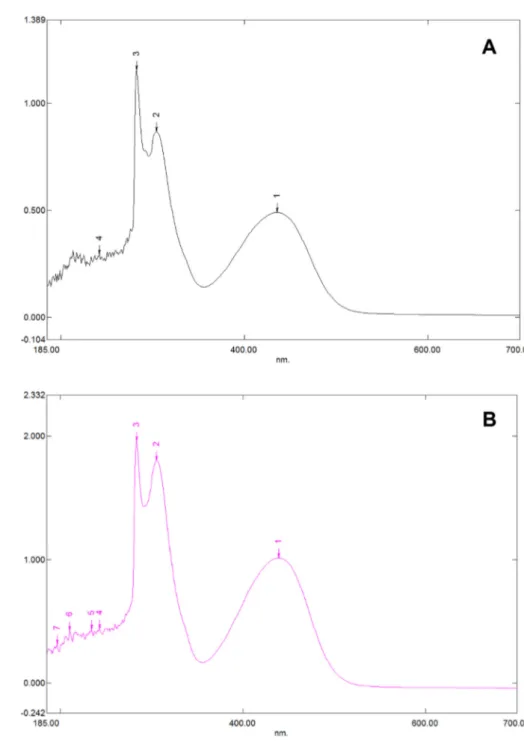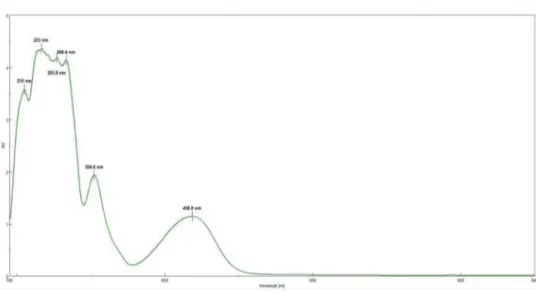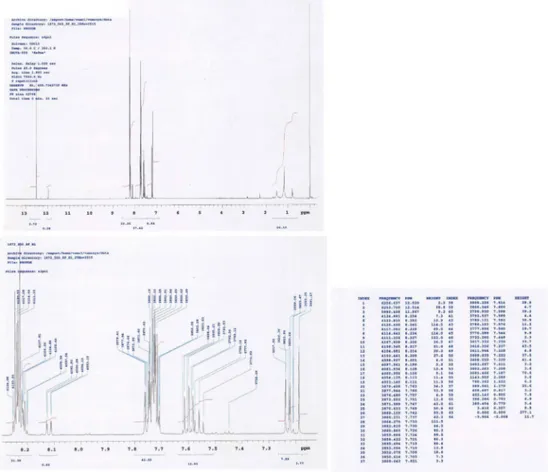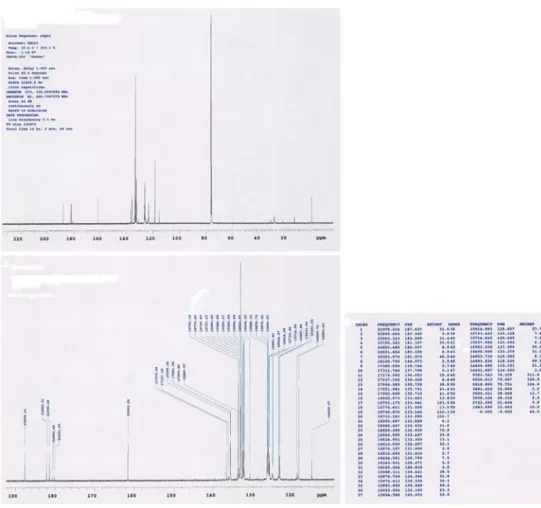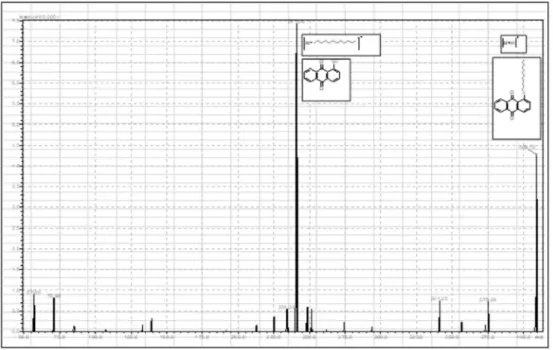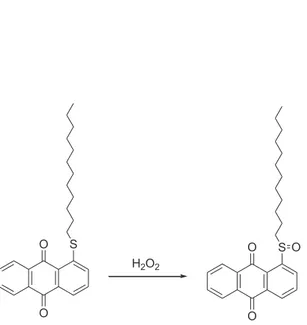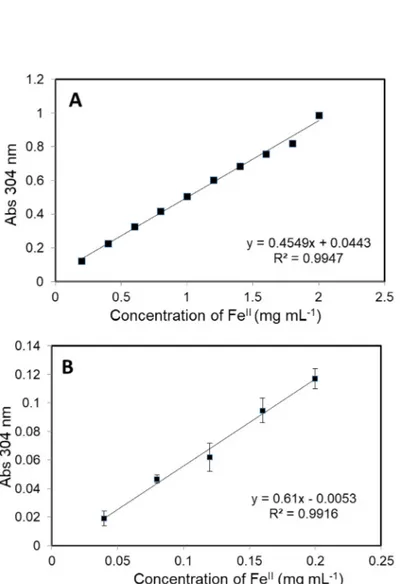ContentslistsavailableatScienceDirect
Data
in
Brief
journalhomepage:www.elsevier.com/locate/dib
Data
Article
Dataset
on
Catal’s
reagent:
Sensitive
detection
of
iron
(II)
sulfate
using
spectrophotometry
Funda
Ozkok
a
,
ǂ
,
Yesim
Muge
Sahin
b
,
c
,
ǂ
,
Vildan
Enisoglu
Atalay
d
,
Kamala
Asgarova
a
,
Nihal
Onul
a
,
Tunc
Catal
d
,
e
,
∗
a Department of Chemistry, Istanbul University-Cerrahpasa, Avcilar, Istanbul, Turkey b Department of Biomedical Engineering, Istanbul Arel University Turkey
c Polymer Technologies and Composite Aplication and Research Center (ArelPOTKAM), Istanbul Arel University Buyukcekmece, Istanbul, Turkey
d Istanbul Protein Research Application and Inovation Center (PROMER)
e Department of Molecular Biology and Genetics, Uskudar University 34662 Uskudar, Istanbul, Turkey
a
r
t
i
c
l
e
i
n
f
o
Article history: Received 30 June 2020 Revised 25 July 2020 Accepted 4 August 2020 Available online 8 August 2020 Keywords:
Catal’s reagent Iron (II) sulfate Spectrophotometer
1-(Dodecylthio)anthracene-9,10-dione Thiols
a
b
s
t
r
a
c
t
Catal’s reagent is characterized by spectroscopic methods suchas fourier-transforminfraredspectroscopy(FT-IR), nu-clear magnetic resonance (NMR) spectroscopy, mass spec-trometry (MS), ultraviolet (UV)–visible spectrophotometry. Effects ofdifferent solvents suchas methanol and ethanol on absorption spectrum of 1-(Dodecylthio)anthracene-9,10-dione (3) were present. Detection range of iron (II) sul-fate using Catal’s reagent was analyzed. Synthesis of 1-(Dodecylthio)anthracene-9,10-dione (3) was explained, and absorbancesofvariousconcentrationsofiron(II)sulfate (0-10mgmL−1)weremeasured.The possibledetection mech-anismwas alsoexplained.Thedatasetisuseful toimprove thedetectionofiron(II)sulfateinvariousapplicationfields suchas environmental,agricultural,sensor,food,textileand cementindustries.
Thestudyrefersto:F.Ozkok,Y.M.Sahin,V.Enisoglu-Atalay, K. Asgarova, N. Onul, T. Catal, Sensitive Detection of Iron (II)Sulfate with aNovel Reagentusing Spectrophotometry,
DOI of original article: 10.1016/j.saa.2020.118631 ∗ Corresponding author.
E-mail addresses: ozkok@istanbul.edu.tr (F. Ozkok), ymugesahin@arel.edu.tr (Y.M. Sahin), tunc.catal@uskudar.edu.tr (T. Catal).
ǂAuthors equally contributed to the study. https://doi.org/10.1016/j.dib.2020.106149
2352-3409/© 2020 The Author(s). Published by Elsevier Inc. This is an open access article under the CC BY license. ( http://creativecommons.org/licenses/by/4.0/ )
Spectchim. Acta. A, 240 (2020), 118631. https://doi.org/10. 1016/j.saa.2020.118631 .
© 2020TheAuthor(s).PublishedbyElsevierInc. ThisisanopenaccessarticleundertheCCBYlicense. (http://creativecommons.org/licenses/by/4.0/ )
Specifications
Table
Subject Chemistry
Specific subject area Analytical chemistry Type of data Table and figure
How data were acquired The data were acquired: FT-IR, NMR, mass spectrometry, UV-vis spectrophotometry
Data format Raw and Analyzed
Parameters for data collection 1-(Dodecylthio)anthracene-9,10-dione was synthesized in the laboratory. Description of data collection Catal’s reagent was prepared and examined using traditional methods. The
data were collected after confirmation of the structure of
1-(Dodecylthio)anthracene-9,10-dione. UV-vis spectrophotometer, FT-IR, 1H-NMR, 13C-NMR, mass spectrometer were used in the data collection. Data accessibility With the article
Related research article F. Ozkok, Y.M. Sahin, V. Enisoglu-Atalay, K. Asgarova, N. Onul, T. Catal, Sensitive Detection of Iron (II) Sulfate with a Novel Reagent using Spectrophotometry, Spectrochim. Acta. A, 240 (2020), 118631.
https://doi.org/10.1016/j.saa.2020.118631 .
Value
of
the
Data
•
A
database
of
Catal’s
reagent
is
essential
for
characterization
of
1-(Dodecylthio)anthracene-9,10-dione
(3)
•
The
data
are
key
for
examining
iron
(II)
sulfate
in
various
samples.
•
These
data
are
an
important
reference
source
for
research
on
developing
novel
studies
to
use
Catal’s
reagent.
1.
Data
Description
This
research
reports
on
a
Catal’s
reagent
data
set
for
detection
of
iron
(II)
sulfate.
Fig.
1
shows
absorption
spectra
of
Catal’s
reagent
in
methanol
(A)
and
ethanol
(B)
solution.
Fig.
2
shows
absorption
spectrum
of
1-(Dodecylthio)anthracene-9,10-dione
(3)
in
acetonitrile
solu-tion
with
lower
scan
rate.
Fig.
3
shows
FT-IR
spectrum
of
1-(Dodecylthio)anthracene-9,10-dione
(3).
Fig.
4
shows
1H-NMR
spectra
of
1-(Dodecylthio)anthracene-9,10-dione
(3).
Fig.
5
shows
13C-NMR
spectra
of
1-(Dodecylthio)anthracene-9,10-dione
(3).
Fig.
6
shows
MS
spectrum
of
1-(Dodecylthio)anthracene-9,10-dione
(3).
Fig.
7
shows
synthesis
of
1-(Dodecylthio)anthracene-9,10-dione
(3).
Fig.
8
shows
oxidation
of
iron
in
presence
of
hydrogen
peroxide
(Fenton
Reac-tion).
Fig.
9
shows
electrochemical
redox
reaction
of
anthraquinones.
Fig.
10
shows
oxidation
of
anthraquinone
derivative
in
the
presence
of
hydrogen
peroxide.
Fig.
11
shows
absorbances
of
various
concentrations
of
iron
(II)
sulfate.
Table
1
shows
absorbances
of
several
compounds
at
the
concentration
of
10
mg
mL
−1in
distilled
water.
2.
Experimental
Design,
Materials
and
Methods
Novel
thio
anthraquinone
derivative
(1-(Dodecylthio)anthracene-9,10-dione)
was
synthesized
by
this
novel
method
for
scientific
applications
[1]
.
Chemical
structure
of
novel
thio
an-Table 1
Absorbances of several compounds at the concentration of 10 mg mL −1 in distilled water. The examined molecules were not reacted with Catal’s reagent under the examined conditions.
Compound Absorbance (304 nm)
Ammonium persulphate -0.032
Ammonium sulphate 0.031
Aluminum potassium sulfate dodecahydrate -0.003
Copper (III) sulphate -0.008
Copper (III) sulphate pentahydrate -0.056
Sodium dodecyl sulphate -0.018
Sodium sulphate anhydrous -0.022
Sodium thiosulphate pentahydrate -0.002
Manganese (II) sulphate monohydrate 0.039
Magnessium sulphate heptahydrate 0.027
Sodium 2-bromoethanesulfonate hydrate -0.029
Sulfanilic acid 0,033
Sodium sulfite anhydrous 0.001
Zinc sulphate heptahydrate 0.006
Sodium 2-chloroethane sulfonate hydrate 0.028
Potassium sulphate 0.037
Ammonium iron (III) citrate 0.012
Iron (III) citrate hydrate 0.038
Iron (II) sulfate heptahydrate 0.985
thraquinone
compound
(
3
)
was
characterized
by
spectroscopic
methods
such
as
FT-IR,
NMR,
MS,
(UV)–visible
spectrophotometry,
and
the
structure
of
the
compound
was
confirmed.
The
thio
an-thraquinone
derivative,
1-(Dodecylthio)anthracene-9,10-dione
(3),
was
dissolved
in
the
following
organic
solvents
to
prepare
the
reactant
named
as
Catal’s
reagent:
Ethanol
and
methanol
(
Fig.
1
).
Tetra
JASCO
6600
spectrometer
used
for
fourier
transform
infrared
(FT-IR)
spectra,
and
Tetra
JASCO
V
750
spectrometer
recorded
Ultraviolet–visible
spectra.
A
Varian
UNITY
INOVA
at
500
MHz
was
used
for
1HNMR
and
13C
NMR
spectra.
Mass
spectra
was
recorded
on
(Shimadzu,
Kyoto-Japan)
LCMS-8030
triple
quadrupole
spectrometer
in
ESI
(
+
)
polarity.
The
absorbances
were
measured
at
304
nM
of
wavelength
using
a
UV-visible
spectrophotometer
in
air
(Shimadzu
UV-2600,
Cat.
No.
206-27600-45,
Kyoto,
Japan).
The
reaction
mixture
was
prepared
as
follow;
1-(Dodecylthio)anthracene-9,10-dione
(3)
(20
mg)
was
added
to
either
ethanol,
methanol
or
ace-tonitrile
(60
mL)
in
order
to
prepare
Catal’s
reagent.
Catal’s
reagent
(50
μL)
was
mixed
with
iron
(II)
sulfate
solution
(100
μL).
Finally,
H
2O
2solution
(17.5
percent
in
distilled
water,
v:v)
(50
μL)
was
added
to
the
mixture.
30
mM
of
trisodium
citrate
dihydrate
(9
mL)
was
then
used
to
sta-bilize
pH
changes.
In
advance,
different
rations
of
the
compounds
could
be
used
to
enhance
the
sensitivity
of
the
reaction
with
Catal’s
reagent.
Catal’s
reagent
can
be
used
for
spectrophotomet-ric
and
colorimetric
detection
of
iron
(II)
sulfate
[4]
.
Fig. 1. Absorption spectra of Catal’s reagent in methanol (A) and ethanol (B) solution. Three similar peaks were identi- fied.
Fig. 2. Absorption spectrum of 1-(Dodecylthio)anthracene-9,10-dione ( 3 ), in acetonitrile solution in lower scan rate.
Fig. 6. MS spectrum of 1-(Dodecylthio)anthracene-9,10-dione ( 3 ). O O Cl HS O O S 1 2 3
Fig. 7. Synthesis of 1-(Dodecylthio)anthracene-9,10-dione ( 3 ).
Fe
3
Fe
2
oxd.
H
2O
2OH
O
O
Anthraquinone derivative
Hydroxy anthraquinone derivative
S
2H
2e
OH
OH
S
reduction
oxidation
Fig. 9. Electrochemical redox reaction of anthraquinones [3] .
O
O
Anthraquinone derivative
S
H
2O
2O
O
S O
Anthraquinone sulphoxide derivative
Declaration
of
Competing
Interest
The
authors
(F.
Ozkok,
Y.M.
Sahin,
V.
Enisoglu-Atalay,
K.
Asgarova,
N.
Onul,
T.
Catal)
declare
patent
application
(Turkish
Patent
and
Trademark
Office,
PY2019-00552;
PCT
International
Ap-plication,
No:
PCT/TR2020/050061– submitted).
Supplementary
materials
Supplementary
material
associated
with
this
article
can
be
found,
in
the
online
version,
at
doi:10.1016/j.dib.2020.106149
.
References
[1] F. Ozkok, Y. M. ¸S ahin, Biyoaktif Antrakinon Anologlarının Sentezine Yönelik Özgün Metot Geli ¸s tirilmesi, TÜRKIYE, Patent, TR 2016/19610.
[2] H.J.H. Fenton , Oxidation of tartaric acid in presence of iron, J. Chem. Soc. Trans. 65 (1894) .
[3] B. Yang , A. Murali , A. Nirmalchandar , B. Jayathilake , G.K.S. Prakash , S.R Narayanan , A Durable, inexpensive and scal- able redox flow battery based on iron sulfate and anthraquinone disulfonic acid, J. Electrochem. Soc. 167 (2020) 060520 .
[4] F. Ozkok, Y.M. Sahin, V. Enisoglu-Atalay, K. Asgarova, N. Onul, T. Catal, Sensitive detection of iron (ii) sulfate with a novel reagent using spectrophotometry, Spectrochim. Acta. A 240 (2020) 118631 https://doi.org/10.1016/j.saa.2020. 118631 .
